No Country for Old Jobs: 10 Charts Showing the Fragile Recovery. Home Sales, Buying versus Renting, Unemployment, and Real Economy Data.
No country can go on spending more than they earn and expect sustained prosperity. Sure, they can get away with a façade of economic stability glazed over by copious amounts of debt but eventually the piper must be paid. The U.S. Treasury in combination with the Federal Reserve has made the ultimate bet that by forcing the dollar lower and injecting easy money into the economy that somehow it will jumpstart the economic engine. If we examine multiple levels of economic activity we are yielding very little overall for trillions of dollars in bailout funds. The big winners here are the banks and the American public is still waiting for the real recovery in the economy.
It is disturbing that there is a significant school of economic thought out there that somehow jobs do not matter. This line of reasoning is baffling. In many ways, this is similar to the collective deep capture that occurred during the housing bubble that somehow prices were justified even in the face of rampant fraud and mass delusion. They don’t call it mania for nothing. Take for example the wonderfully unstable budget of the biggest state of our country, California.
Only last week, State Controller John Chiang announced that the state is falling behind $1.1 billion in receipts from a budget only enacted three months ago. Keep in mind the estimates made only a few months ago were conservative by California standards yet somehow money isn’t coming in. This is occurring at the same time that the state has hiked taxes and is also front loading tax collections earlier. To the obvious person on the street, you cannot tax someone without a job. Well, that isn’t necessarily true because you can tax them on items they buy (in some counties like L.A. that rate is near 10 percent).
We are now 21 months into this recession. Job growth is no where on the horizon. It would appear that people are waiting for some ambiguous industry to emerge out of the ashes like some financial Phoenix. Will it be the green sector of our economy? Yet even in that optimistic scenario, does that sector have enough to make up for the 8 million jobs lost in this recession and the growing demands from a larger work force? If we examine eras like the 1920s in Florida and their real estate bubble, prices did not come back for years. So if you factor in the 1920s coupled with the Great Depression of the 1930s, things didn’t turn around for nearly two decades. California and Florida are coming off unsustainable highs. What does this mean? Let us go back to the State Controller report. What that translates to in the real economy is less money coming in to the government. And that means either more tax hikes or more spending cuts.
Let us take a look at a sign of economic vitality. U.S. Exports:
Source:Â Federal Reserve
Does that chart look like a recovery to you? Keep in mind the above chart factors in every imaginable bailout and trillions funneled into the financial sector. Yet exports haven’t moved. Before we can talk about housing rebounding and moving upwards shouldn’t we talk about the real economy first?
In this article we are going to examine 10 charts from housing to auto sales that show not much has changed at the core of the economy.
Chart 1 – Auto Sales
As it turns out, cash for clunkers was merely a way to frontload auto sales. After seeing a spike in August sales the September number fell back to the year long trend. As one colleague told me, we helped stimulate the foreign auto maker market since most of the cars bought were non-domestic in brand. Talk about a horrible strategy. Given that we now own GM and Chrysler making the U.S. government auto CEO, why would you want to reward your competitor? Seems like our politicians don’t think things through because a one month boost came with an expensive price tag.
And is this even the right way to go? Again, non-domestic auto makers make up a big part of our economy even though many provide jobs outside the U.S. I’m all for open trade. But why is the American taxpayer subsidizing this? As we had speculated back when the cash for clunkers program was announced, this was a big gimmick like Hope Now and other policies that have yielded poor results in action.
Chart 2 – Housing Starts
This chart should tell you the big story regarding home building. Sure, single family building is up a bit but wouldn’t you expect that with trillions being funneled into this industry? But look at the chart closely. Notice the multiple housing starts? Still at record lows. Why? Because the market is saturated with inventory! So trying to spur more building when we are seeing some 300,000 distress actions on homes hitting the market each month just doesn’t make sense. If anything, it will prolong this housing slump.
Housing starts have fallen so hard that we have to go back to the Great Depression to find another similar trend. It would seem that those calling bottom somehow believe that we are heading back to those 2005 and 2006 points. We are not. In their mind, everything is boom and bust. No middle ground is allowed. Let us assume we are back on normal ground. Then what? Why rush to buy a home now? If we are back on normal footing then housing should reflect employment conditions. After all, most Americans pay their mortgage from wages. So until employment and wages move up, there is little rush to purchase a home right now and later charts will highlight why.
Chart 3 – Single Family Home Sales
The stabilization with home sales is largely due to the big amount of distress sales going for rock bottom prices. Couple this with the Federal Reserve buying agency debt and keeping mortgage rates at historical lows and home buying conditions seem prime. Add fuel to the flame with an extremely expensive $8,000 tax credit and sales go up. It is simple. Just like cash for clunkers. Yet what happens when you remove that tax credit? Cash for clunkers gives us a crude look at what will happen.
And look at new home sales. They are off their lows but nothing remotely close to their peak days. So this chart ties in with the previous chart because all the action is in the existing home market. No need to build homes when people are buying and selling already made homes. So much for those construction jobs.
Chart 4 – 30 Year Mortgage Rates
If you look at the chart above you can thank the Federal Reserve and U.S. Treasury. What you don’t see is the parallel destruction of the U.S. dollar for these cheap mortgage rates.  There is no free lunch. Mortgage rates are near historical lows. Rates hovering at 5 percent don’t even mesh with historical standards. Over the past 40 years the average 30 year fixed rate has averaged 9 percent. That is, if we even revert to the mean rates will double meaning the amount people pay on a monthly basis will explode.
With Alt-A and option ARM loans not even eligible for these rates, how does this help distressed owners? It doesn’t. The market is artificially being juiced with trillions of dollars and at some point, something has to give. The Fed is betting the economy will miraculously find some other bubble (i.e., technology, real estate, ?) and will expand again. Yet we may be out of bubbles for the short term.
Chart 5 – Personal Savings Rate
Americans started saving at a pace not seen in decades. Yet the cash for clunkers program and the home buying tax credit once again got people out and buying. But is this sustainable? It is too early to tell. The recent dip is because of these last two programs. The next phase will be the holiday shopping season. Many retailers depend on the November and December months for a large chunk of sales. We will soon find out how tapped out the average American is. Last year, people went out shopping like crazy even though economic indicators were equally poor.
Yet over this year, credit card companies have been yanking lines in light of higher default rates. Without the plastic, will Americans shop till they drop this Christmas?
Chart 6 – Hours Worked
The work week has gotten shorter. So short, that it is the lowest it has been in record keeping history dating back to the 1960s. The average American work week is now down to 33 hours. Keep in mind this is for the employed. If we look at the under utilization rate (includes fully unemployed and those working part-time for economic reasons) the U-6 rate is up to 17 percent. The above chart reflects those but also those who supposedly have full-time jobs.
What is occurring is overtime is being cut and furloughs are being implemented like the 200,000 state workers of California that are now earning less. Earning less means less money to spend. The state is learning this lesson quickly. Jobs absolutely matter. The problem is Wall Street has captured our political process and convinced many that if Wall Street is happy, somehow little crumbs will trickle over onto Main Street and all will be well. So far, politicians have given everything the bankers have requested and nothing has changed on the streets of America. How is TARP working out?
Chart 7 – Household Debt Burden
Even as debt is being destroyed through foreclosures and bankruptcies, many households are still in record amounts of debt. Why? Because losing jobs and less pay reflect a new reality even though the system is washing out old obligations. Debt is not wealth as many are now realizing.
This above chart may show why the American consumer is reluctant to go out and spend without getting massive incentives like cash for clunkers and home buying tax credits. Are we now going to give Americans a $1,000 holiday shopping voucher? Some in the retail sector have asked for similar goodies. Make no mistake that the crony bankers will ask for anything to fluff their own profits.
Chart 8 – Household Debt Service
Now the above is a fascinating chart. What we see is a trend of less financial obligations for renting households. Rents have been falling across the country. This only makes sense since people are earning less. However, the financial debt obligation of homeowners is still near peak levels. Same amount of debt on a home that has seen equity evaporate.
Many people are now unable to qualify to buy a home and that is okay. We need to remember that during the bubble anyone with the desire to own was given that opportunity. Alt-A and option ARM products were the mortgage of choice for many. We are dealing with the repercussions of those decisions even today. In fact, we have yet to deal with them since 2010 to 2012 will bring many of these home loans to roost.
Chart 9 – S&P 500 Double Bubble
The above is perfect chart of the double bubble we have experienced in the last decade. It is interesting to see the recent trend as if a triple bubble is in store. The market is trending as if we will have a V shaped recovery. As we have seen with all the data above, if anything the cliff diving has stopped but this does not equate to a booming recovery. We are betting on another bubble even in light of no job growth and also trillions in bad loans coming due soon including commercial real estate.
The market price/earnings ratio is still high. It believes that 2010 will somehow bring back a 2005 year. But digging beyond the debt, 2005 wasn’t a stellar year. The only reason it looked stellar was the mania in housing and absurd financial sector profits. The financial sector profits are back with taxpayer money but the boom in construction is nowhere to be found. Unemployment is also officially nearing 10 percent.
Chart 10 – Health Care Employment
Maybe the next bubble is in healthcare? This chart tells you the story of an aging population that doesn’t make much anymore since it has outsourced a gigantic portion of its manufacturing base. Many younger workers are looking at boomers who lived up the 1960s and 70s, got serious in the 1980s and 90s and now are expected to shoulder the burden of their entitlements all the while understanding that they will not have those benefits when they retire. If anything, just look at the ages of those on Wall Street. The young brokers were merely fodder in the recent downturn as we saw these young Gordon Gekkos walking out of places like Lehman Brothers brown box in hand with desk goodies and a sad look on their face. Yet their bosses made out with millions in bonuses. So much for company loyalty.
Healthcare costs are growing and so is this part of our economy. With many boomers retiring in the next few years, an inordinate amount of stress will be put on our system. Younger generations are not having gigantic families anymore. So there are fewer people paying into the system for an enormous size of our population who will now start collecting. Social Security is minimal with average payments around $1,000 to $1,300 a month.
Yet younger workers are looking at this and also seeing these workers with pensions of $4,000 to $6,000 per month (and higher) and are now told to put their money into the 401k casino and hope it makes out because Social Security will be a shell for them when their time comes. Many have lost thousands in this recent crash that was the deepest since the Great Depression.
I doubt healthcare will be the next boom. This is a cost to our economy that is only set to go higher as people retire. What is the boom going to be in? Viagra? With annual sales of over a billion, maybe this is the boost the economy needs. I mean is this what it now boils down to? We need to get back to making things. The economy for much too long depended on youngsters in front of Bloomberg terminals punching in keys and trading billions of dollars as if it were the new version of Halo. Then the “real economy†was largely based on everyone dressed up in a suit pretending they were the next HGTV flip this house expert and trading homes like baseball cards. It was so easy. Paper pushing and house flipping. Heck, at least in the technology bubble we were left with some great companies. What are we left with after this housing boom? Gigantic McMansions for families that don’t even plan on having that many kids.
Until jobs start showing up, any talk of a rebounding housing market is moot especially with this entire artificial stimulus still bouncing around the economy. And collapsing tax revenues are not a good sign. I don’t buy the jobless recovery argument and the government tends to agree. If all is well, why is the U.S. government and Fed buying $1.25 trillion in agency debt to lower mortgage rates, putting in place an $8,000 tax credit, boosting car sales with gimmicks, encouraging risky low money down loans with FHA insured products, and extending unemployment insurance to a record 92 weeks in states like California? Do these things sounds like policies of a booming economy?
 Did You Enjoy The Post? Subscribe to Dr. Housing Bubble’s Blog to get updated housing commentary, analysis, and information.
Did You Enjoy The Post? Subscribe to Dr. Housing Bubble’s Blog to get updated housing commentary, analysis, and information.

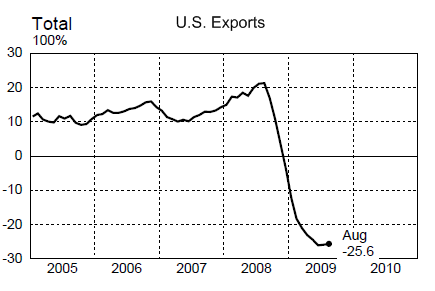
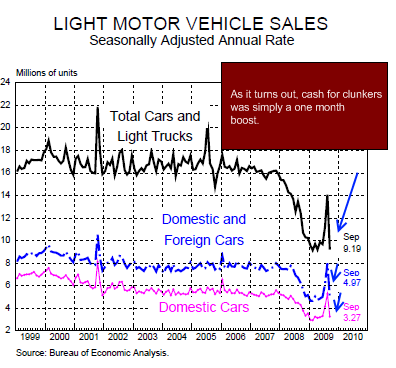
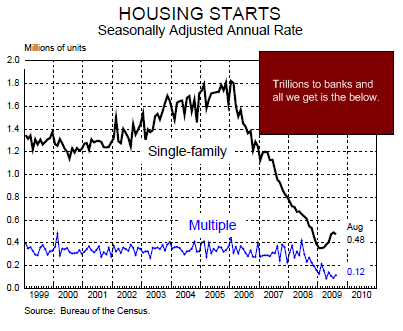
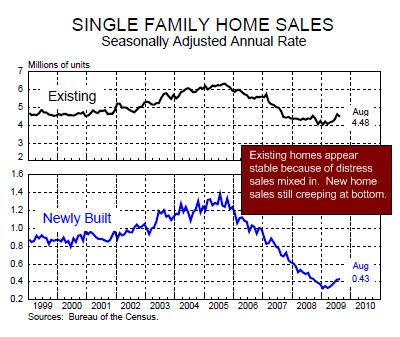
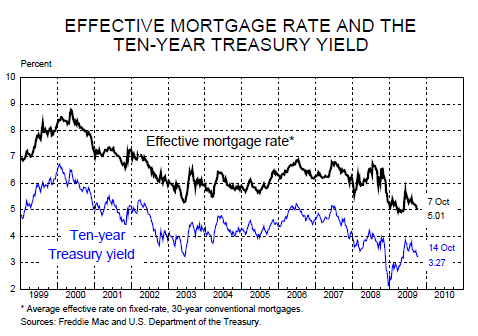
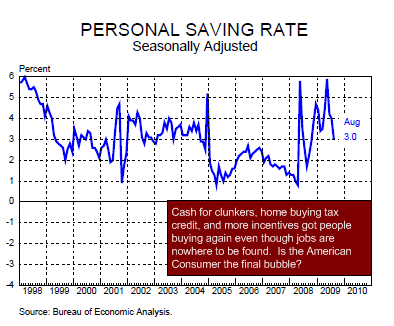
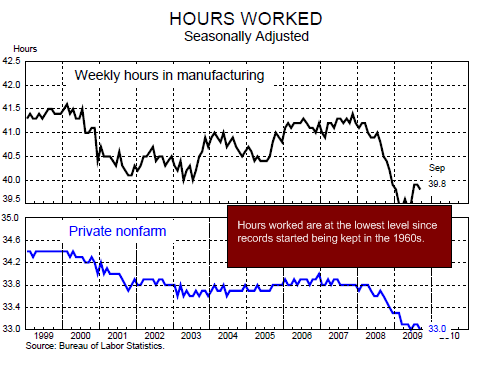
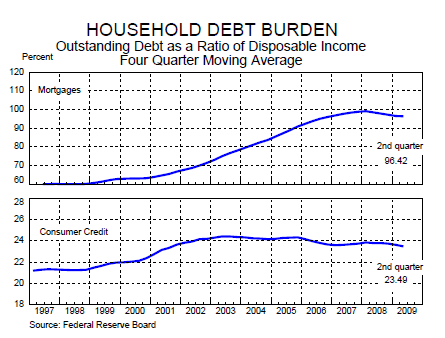
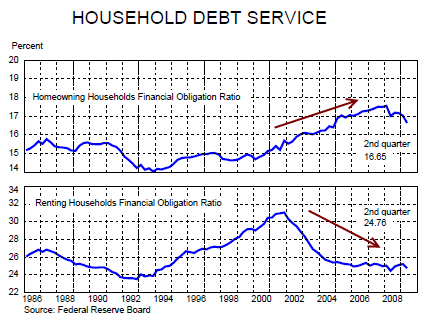
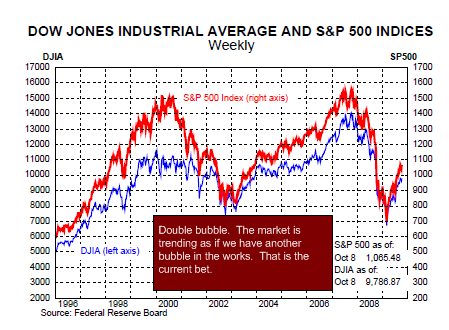
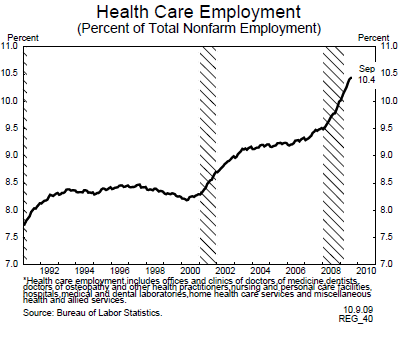
 Subscribe to feed
Subscribe to feed






22 Responses to “No Country for Old Jobs: 10 Charts Showing the Fragile Recovery. Home Sales, Buying versus Renting, Unemployment, and Real Economy Data.”
A jobless recovery is not a recovery for those who are jobless, nor to the people who are financially dependent on the jobless. The crony capitalists are dependent on their cronies, so they are having a robust recovery.
Green Shoots. (you don’t hear that expression much, anymore)
10,000 Apply for 90 Factory Jobs
In the latest sign of weakness in Louisville-area employment, about 10,000 people applied over three days for 90 jobs building washing machines at General Electric for about $27,000 per year and hefty benefits.
“In this recession, there are lot of people who are just about to run out of unemployment benefits,†said Richard Hurd, a labor relations professor at Cornell University. The national average of time unemployment benefits collected now stands at 26 weeks, Indiana University Southeast Professor of Business Uric Dufrene said.
I dunno, I see a tiny uptick in exports in that first chart. Lower dollar=exports cheaper/imports more expensive. Good chance to rebuild some of the manufacturing infrastructure.
A lot of those “import” cars were assembled in North America-at least the Hondas, Toyotas, Kias, Hyundais and Nissans.
Maybe the next boom will be rebuilding crumbling infrastructure?
If you are looking for a bubble in its late stages, look no further than higher education. Colleges and Universities have had annual price increases similar to healthcare – far in excess of inflation for many years. Now state budgets are hurting, college endowment funds took a big hit. Student loans? What does the future hold here? Parents’ finances? Don’t look so good. The rich will continue to go to private schools. The middle class? These graduates will be saddled with enormous student loan liabilities. For what? Teaching 3rd grade? They will be paying for 20 years, seriously impacting their future spending ability. This could end badly.
California first-time jobless claims at record and counting
October 12th, 2009 by Mary Ann Milbourn Orange County Register
http://economy.freedomblogging.com/2009/10/12/california-first-time-jobless-claims-at-record-and-counting/
(Excerpts): California is seeing record numbers of first-time jobless claims with more filings in the first nine months of this year than in the previous 3 1/2 years combined, state Employment Development Department officials report.
This year Californians filed 182,736 initial claims for unemployment through September. From June 2005 through December 2008 — 42 months — 179,461 total first-time claims were filed, said Loree Levy, an EDD spokeswoman.
California has been particularly hard hit because so many of its jobs were tied to mortgage, real estate and construction. As of August, nearly 2.3 million Californians were unemployed, pushing the jobless rate up to 12.2%, the highest by state estimates since December 1940.
Modern manufacturing is a monster that needs to be fed 24/7 since its ROI is based on volume output. Manufacturing jobs so to speak really should be discussed in the past tense not only in America but on a world wide basis. What is occurring reflects the output capacity that is modern manufacturing, huge over supply, and the in- ability of society to absorb this excess.
The idea that creating a FIRE based economy diversified from over reliance on blue collar jobs would be the missing link in creating the forever boom is another myth and on the other hand modern manufacturing technology makes it difficult to think about returning to a manufacturing driven job base.
Yet younger workers are looking at this and also seeing these workers with pensions of $4,000 to $6,000 per month (and higher) and are now told to put their money into the 401k casino and hope it makes out because Social Security will be a shell for them when their time comes.
___
>>
Actually Doc that is inaccurate.
>>
Just 21% of all U.S. workers are covered by traditional pensions, and the number shrinks every year.
>>
And I have read a LOT of employment contracts and pension plans over the years before I retired from practicing employment law, and never saw one that routinely paid out “$4000 –6000.†Typically on average it was between $1000 –3000 tops.
>>
The switch to 401Ks (save the employer lots of money) began close to 30 years ago and began the fad around 20-25 years ago. Those between the ages of 40 –65 got hit the hardest as first they had a pension then they didn’t and all that was left was the 401k.
>>
BTW, the â€boomers†are between 45/46 –63. That means for those between 50-63, they started their careers with a pension and between the ages of 30 –48 got dumped into a 401k. The ones hurt the most by the switch were those who were 40 and up when they got stuck with a 401k instead of the pension.
>>
And we know that 401ks do NOT work in the end.
>>
The idea that all or nearly all individuals can save enough on their own during their working years to pay for 20-30 years of retirement is nuts. It has NEVER HAPPENED in the course of recorded history.
>>
The math simply does NOT work. Inflation over the past 30 years has run around 300% , ie: if you had $100 in 1989, you need $297 in 2009 to buy the same thing. Over the past 20 years is it 75% meaning if you had $100 in 1989, you need $175 in 2009.
>>
Now saving enough over 40 years of work while paying all necessary expenses during those 40 years AND then ending with 20 years of living expenses + 75% more in retirement funds CAN NOT HAPPEN! Here is the math:
>>
Median wage in 2009 = $30000 or so.
>>
Adjusting for inflation using the rate of the past 40 years means a median wage of $176,431 in 2049.
>>
By 2069 (20 years after retirement), the person would need an income of $272,000.
>>
Ergo they would have had to have saved at least $4,484,310 —-maybe a little less if it is in safe things like munis and paying 4% interest a year.
>>
With the average wage of $30000 –176400 over 40 years, the person’s lifetime earnings were only $4,128,000.
>>
Now the ‘financial planners’ say to only use 4% of retirement funds a year. Assume the person only needed 80% of their pre-retirement income. Social Security maxes out at around $1900 a month with the average being $1100. With the average payment of $1100, the person would have $13,200 a year. If they need $24,000 a year (80% of the average wage), they are short $10,800. For that $10,800 to come from their 401k and only be 4%, they would need $270,000. Now add on for inflation so that 20 years after retirement, they need $18,900 from the 401k. That means their average withdrawal over 20 years would be $14850 so they need to start with $371,250.
>>
Uh huh……right now their income is $30000 and they are retiring. 40 years ago the average wage was around $11000. Over their 40 year worki history, they would have had an average income of $20,500 and lifetime earnings of $820,000. In order to have that $371,205 they would have had to have saved at least $185,625 and earned 5%+ a year on their savings. They can not have lost any money at all (market drops etc.) They would have had to have saved at MINIMUM around 23% of their gross income or around 27% of their net income – while paying for housing (28% of income), healthcare (up up up), taxes, utilities, transportation… and oh yeah, put the kids through college or at least help.
>>
Note: Social Security will ‘be there’ for younger workers assuming that they breed and produce the next generation of workers who will then pay in. It is NOT a savings account. The contributions of current workers go to support retired workers – and that is the way it has always worked. It mimic the pre-Soc Sec days when the younger workers in a family supported the members in the family who were ill or too elderly and unable to work.
>>
BTW, I don’t see healthcare as ‘bubble’ or growth industry. It doesn’t ‘make’ anything. All it produces are services which are an end consumption product. It can’t grow because its customer base can’t afford its product if the base doesn’t have an income. An economy based upon giving each other flu shots won’t work any better than one did based upon selling each other houses or knick-knacks from China or massages or spa visits or dogwalking services or……..
@Ann,
Ouch, we’re Americans–we can’t handle the truth.
Ann S. is incorrect- 21% of private industry workers are covered by pensions, but 100% of government workers are covered by extremely generous pensions.
In Calif. alone, over 5,000 people get pensions of $100,000 a year or more from state government jobs. see
http://www.pensiontsunami.com
AnnS: So many painful truths in one diatribe… I Love you, man. er, I mean woman.
Doctor Housing Bubble and all of your cohorts, you guys are a bunch of perma bears/losers/people who hate America.
America has always been a strong nation. A nation that doesn’t walk away from adversity but faces it head and on and wins time and time again. DO NOT COUNT AMERICA OUT. AMERICA’S BEST DAYS ARE AHEAD, NOT BEHIND.
We are the greatest, most prosperous and most free nation this world has even seen. We will get through this rough economic patch. And as usual, those who doubted America will have egg on their face.
check this out:
http://lansner.freedomblogging.com/2009/10/13/30-gain-predicted-for-socal-home-prices-by-2012/40073/
unbelievable!
@ Eli
Assuming you’re not simply trolling and are above the age of twelve, our problem is that the foundations of the “strong nation” you speak of are being eroded by banksters and crony capitalists. Our Founding Fathers didn’t build this country by reselling cheap Chinese cr@p and McMansions to each other. My main beef is that our leaders have chosen the path of obfuscation and deception over standing up and facing the root problems of our current crisis like grown @ss men.
Robert Cramer
>>
I stand by the data I gave. 21% of ALL employees.
>>
That site to which you link is not objective – look at its focus. It has a political agenda – a libertarian, right-wing agenda.. Hell’s bells the NAME of the unknown bloggers gives that away!
>>
Accepting for a moment (though you provide no hard data from an independent source) that 5000 public employee retirees in CA draw $100,000 or more in pensions, so what?
>>
What is an appropriate retirement for someone with one or more college degrees who ran a department with a few thousand employees and managed a multi-million dollar budget? (And given size of state, county and local government in California – all proportionate to the population exactly as it has been for decades – there will be a lot of such upper level managers.)
>>
Don’t hear you whining about the multi-million dollar pension funds of corporate CEOS.
>>
BTW, a very well known econ blogger whose posts are avowedly libertarian was up to my area over Labor Day and we got together for dinner. They were camping. And the funniest part is that this libertarian choose to stay in the PUBLIC campground operated by a government agency rather than staying in private campgrounds which cost over twice as much. Funny thing about most anti-government people. They stop hating government when it is their wallet on the line and government services save them money or they need a cop NOW.
Sounds like Eli’s mommy took away his XBox.
Hmmm…wonder if that XBox was made in the U.S.
AnnS, many of us don’t complain about the pensions and benefits given to private sector CEOs because we have the option to not buy products from that company. Private unions share the same benefit. If I think GM pays their assemblers too much money, and that high pay is reflected in a higher price for a car with lower quality, I buy an “import”. Problem solved. This is not the case with public pensions, which we are all on the hook for.
Good article. The recession is not over, and the dollar is really beginning to lose traction. Ben Bernanke has two choices, and only two choices: continued recession or hyperinflation. Something tells me that by next fall (coincidentally the mid-term elections) we are going to hear a whole lot more of how great the economy is doing despite those pesky statistics…
Not quite sure about your health care industry assessment. There will be a lot of opportunities for savvy entrepreneurs in pharmaceuticals, auxiliary services, medical equipment, etc.70+ millions will retire by 2020, providing of course, that a lab created bug don’t get rid of us way before that.
Currently, interest rates are lower than they have been in some time. If you are thinking of buying a home, now is certainly the time to do so. A recent market report reflects that U.S. property has become an increasingly more attractive opportunity for home buyers and investors. U.S. property values in many areas are at an all time low thus causing much upside potential. Knowing where not to buy a home is as important as are the dos and don’ts of buying a home. There is a tool which can erase all the confusion related to home buying. It’s a tool which Identifies properties with the most value, establishes the right price range to pay, projects long-term cash flow and appreciation & assesses how to maximize after-tax returns. For more information look into http://www.smartzip.com/info/score
Andy Paul–
Shut-up.
We all know that “Andy Paul” is a RE shill, but it bears repeating that the WORST time to buy a home is when interest rates are at their LOWEST because when interest rates rise (inevitable), that same house becomes LESS affordable to the next potential buyer, thus limiting the home’s potential to appreciate. Plus, buying when interest rates are higher affords the buyer the opportunity to refinance when rates go down.
Dont make the mistake that Cash4Clunkers(tm) was about stimulus, that is only how it was sold to a braindead public. We’ve been sold many costly things over the past year under the guise of stimulus – few if any targeted specifically at improving our economic situation (just look at the line items in the last big stimulus bill). C4C was a federal version of long standing state programs to destroy older cars and replace them with high-mileage cars. Nobody gave a crap about US stimulus, hence the non-accidental absence of a domestic-only provision in the program.
Leave a Reply